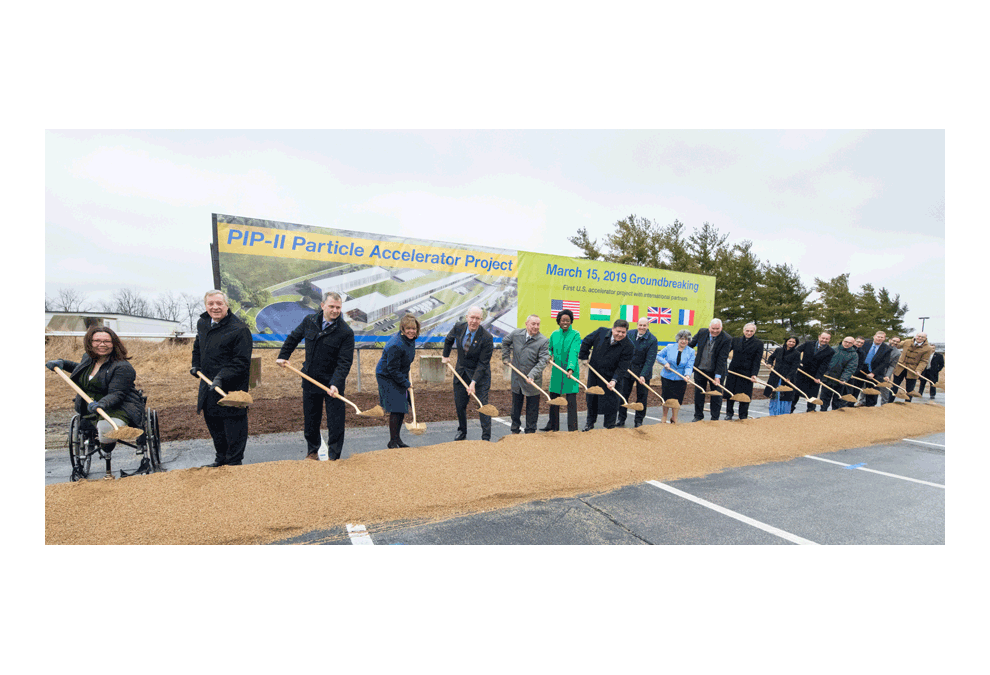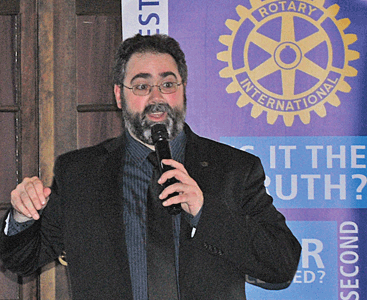
With a ceremony held Friday, March 15, the U.S. Department of Energy’s (DOE) Fermi National Accelerator Laboratory officially broke ground on a major, new, particle accelerator project that will power cutting-edge physics experiments for many decades.
The new 700-foot-long linear accelerator, part of the laboratory’s Proton Improvement Plan II (PIP-II), will be the first accelerator project built in the United States with significant contributions from international partners. When complete, the new machine will become the heart of the laboratory’s accelerator complex, vastly improving what is already the world’s most powerful particle beam for neutrino experiments and providing for the long-term future of Fermilab’s diverse research program.

Andre Salles, Fermilab media and community relations specialist, gives a presentation at the Rotary Club of Aurora Monday about recent events at Fermilab, America’s partical physics and accelerator laboratory in Batavia.
Jason Crane/The Voice
The new PIP-II accelerator will make use of the latest superconducting technology, a key research area for Fermilab. Its flexible design will enable it to work as a new first stage for Fermilab’s chain of accelerators, powering both the laboratory’s flagship project, the international Deep Underground Neutrino Experiment (DUNE), at Fermilab, and its extensive suite of on-site particle physics experiments, including searches for new particles and new forces in our universe.
DUNE is under construction, and will be the most advanced experiment in the world studying ghostly, invisible particles called neutrinos. These particles may hold the key to cosmic mysteries that have baffled scientists for decades. The DUNE collaboration brings together more than 1,000 scientists from more than 180 institutions in more than 30 countries, all with a single goal: To better understand these elusive particles and what they can tell us about the universe.
The PIP-II accelerator will enable the beam that will send trillions of neutrino particles 800 miles through the earth to the four-story-high DUNE detector, to be built a mile beneath the surface at the Sanford Underground Research Facility in Lead, S.D.. With the improved particle beam enabled by PIP-II, scientists will use the DUNE detector to capture the most vivid 3-D images of neutrino interactions ever seen.
PIP-II is a groundbreaking scientific instrument, and its construction is pioneering a new paradigm for accelerator projects supported by the U.S. DOE. The accelerator would not be possible without the contributions and world-leading expertise of partners in France, India, Italy, and the UK. Scientists in each country are building components of the accelerator, to be assembled at Fermilab. This will be the first accelerator project in the U.S. completed using this approach.
With PIP-II at the center of the laboratory’s accelerator complex, Fermilab will remain at the forefront of particle physics research and accelerator science for the foreseeable future.
The groundbreaking ceremony March 15 for the PIP-II accelerator was attended by dignitaries from around the globe. Speakers included Illinois governor JB Pritzker, U.S. senators Dick Durbin and Tammy Duckworth, congressmen Lauren Underwood (IL-14), Bill Foster (IL-11), Robin Kelly (IL-2), and Sean Casten (IL-6), DOE under secretary for science Paul Dabbar, University of Chicago president Robert Zimmer, and national and international partners in the project.
Click on the links below for more photos and video:
- Photos and videos: http://pip2.fnal.gov/gallery
- Information about the project: http://pip2.fnal.gov
- Video on the global benefits of the LBNF/DUNE experiment: https://www.youtube.com/watch?v=cBGXMYP8cq8
- Press release with images: http://news.fnal.gov/2019/03/fermilab-international-partners-break-ground-on-new-state-of-the-art-particle-accelerator
— Fermilab

